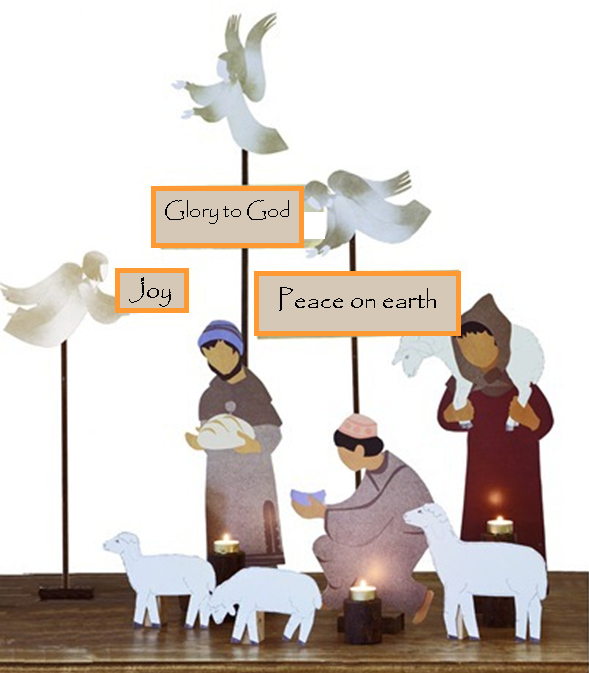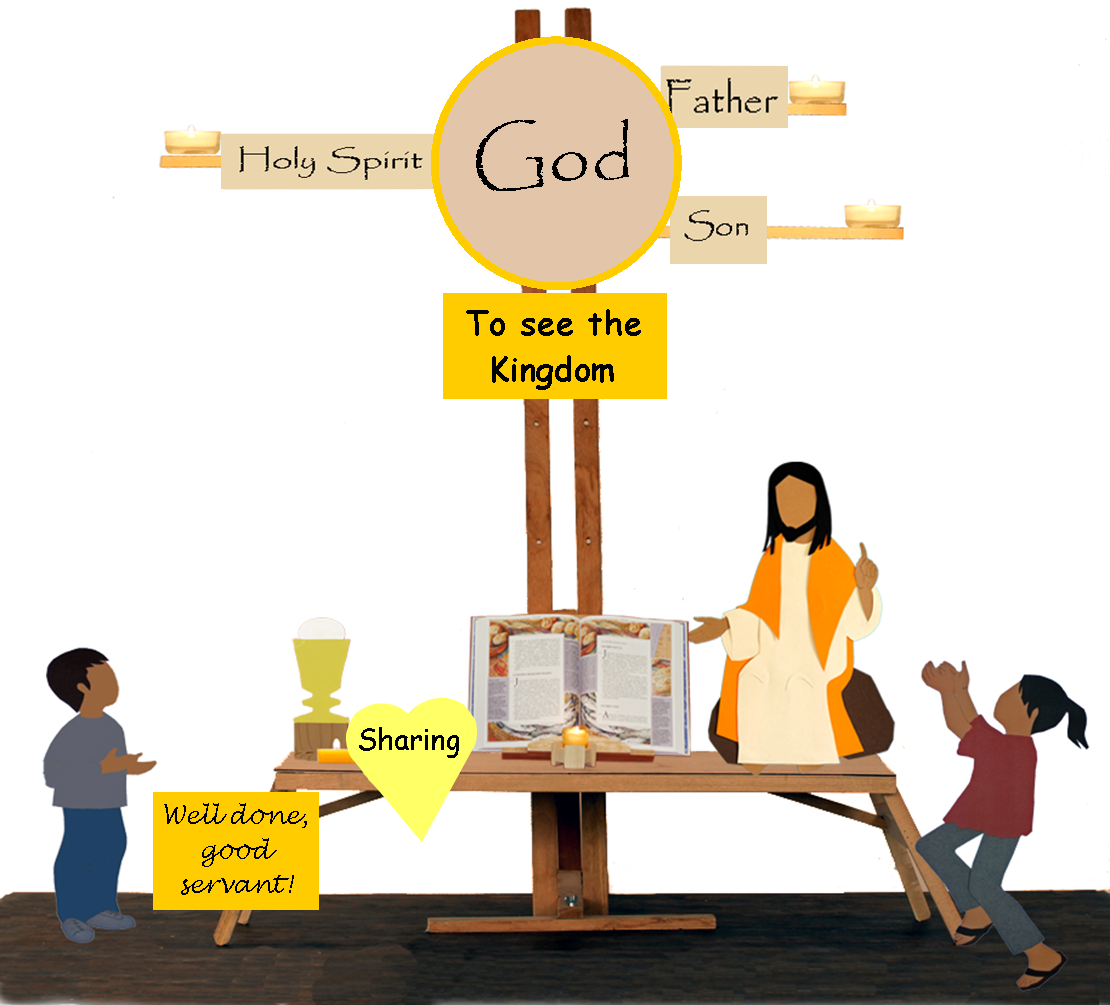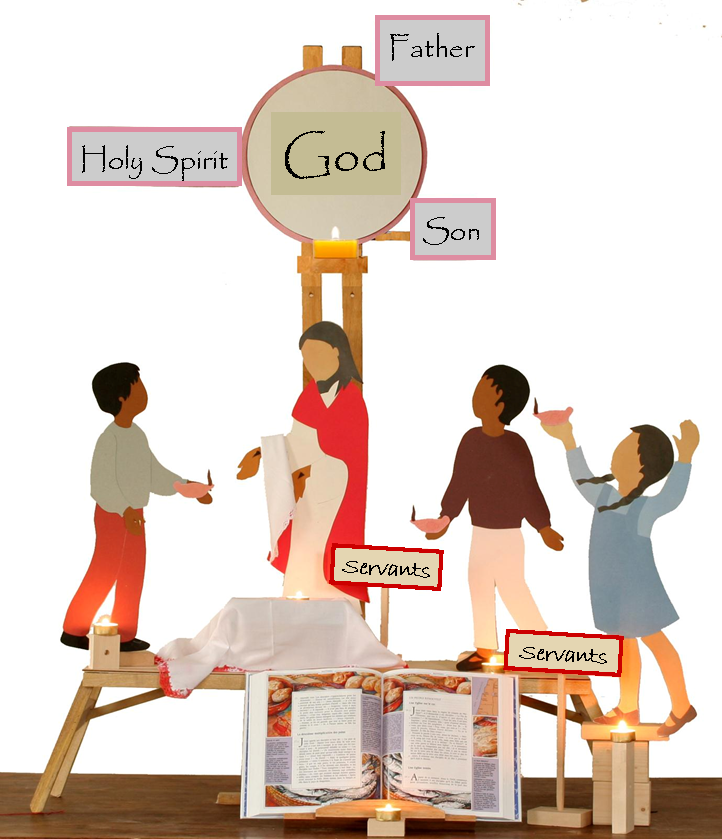EXAMPLE OF A SESSION IN THE CATECHIST’S BOOK
PREPARING THE SESSION
- The catechist’s preparatory study – personal or as a group
Before opening the Scriptures, say a prayer together to the Holy Spirit, the “interior Master”.
“What comes from the Spirit is not fully understood except by the Spirit’s action” CCC137
“Holy Scripture must be read and interpreted in the light of the same Spirit by whom it was written” DV 12,3
Reading the Word of God
- Read the next catechetical session’s extract from the Word of God. It can be read alone or as a group, in silence or out loud. Take if possible the liturgical version of the Bible, because this is the one the children will hear during the Eucharistic celebration. Different versions can also be used, since they may shed light on each other.
- Question the text: Who? Where? When? Why? How? What is the situation at the beginning and at the end?
- Place the extract in its wider setting. What is happening just before and just after the text? What is the general context?
- Note down and share your first discoveries.
- Write down or tell what has struck you, what you find puzzling…
Studying the Word with the heart and the intelligence of the Church
- Read the parallel accounts in the synoptic Gospels, mark the differences and the similarities…
- Drawing from the footnotes and the biblical references to other passages of Scripture, whether in the Old or New Testament, try to deepen your understanding of the text.
- Find the reference to the extract in the index of citations at the end of the Catechism of the Catholic Church in order to take account of Tradition’s understanding of it. You can go further thanks to the subject index.
Letting the Word transform our hearts
After this time of sharing, read again the extract out loud, without comment, and let it penetrate your heart during a time of silent prayer.
- Preparation towards handing on the Word of God to the children
Find an answer to the following questions:
What is the message that is going to be handed on?
- Take account of the children’s age and spiritual maturity.
- Place the session within the year’s catechetical journey, and also take account of the preceding and following years.
- Focus on the main point of the session and on the spiritual attitude to be imparted.
How can we deliver the Word so that it touches the heart of those who listen to it?
- Look out for the words that will need to be simplified or explained
- Prepare the hymns and the music that will best help the children take on and memorise the Word
- Discern which word, which sentence, which pictures, which cardboard silhouette should be particularly emphasized.
When should we leave a moment of reflection or a moment of personal prayer?
This is to be discerned during the preparation of the session.
How can we help translate the message into life?
- Discern which activities would best help focus on the main point of the session (drawings, games, manual activities…)
- Encourage the children in different ways to live as Christians in their daily life (at home, at school…) and to bear witness in their own situation.
How can we end this time shared together in the Church?
Find out which connections can be made with the liturgy, with the Parish community, with the week’s intentions of prayer, with the children’s own families.
SETTING FOR THE CATECHETICAL SESSION
Before the session, the catechist will have prepared the room: it should be clean and welcoming, separated into two spaces :
- An area called ‘the House of Nazareth’ is set out with tables and chairs in a welcoming manner. This is where the children first come in, meet with each other and with the catechists, share and discuss. This is also the place set aside for the children’s practical activity once they leave the ‘Holy place of Meeting’ towards the end of the session.
- The ‘Holy place of Meeting’ is set apart for prayer and for the teaching session. The children will sit there on a carpet or cushions. The visual aid can be displayed with the name GOD, a few card figures representing the children who are listening, praising or praying.The children know that they need to be quiet in order to freely come into the ‘Holy place of Meeting’. Towards the end of the session, the children can remain in prayer for as long as they wish in the ‘Holy place of Meeting’, whose purpose is to meet with God, in his Word and in prayer. Those who do not wish to pray any longer are then free to go into the ‘the House of Nazareth’ and leave the others to pray in silence.
THE STRUCTURE OF A SESSION
“Central aspects of the formation of children are training in prayer and introduction to Sacred Scripture.” GDC 178
Welcoming the children
A welcoming atmosphere, where love and faith can be felt through a thousand small but tangible details is not neutral.
The catechist should be available to listen to each child, giving each one full attention, in order to know the children better.
This first experience of shared Christian life, in the trust-filled environment of fraternal help and unconditional commitment, is often the children’s first encounter with the Church.
It allows the children to experience the Christian community and to appreciate the beauty of living within this family.
This time of mutual encounter, of getting to know each other and of sharing together is indispensable: it opens the door to the Word.
Opening the heart – Relying on the gratuitous love of God
The children are taught to perceive the sacred and to enter into the liturgy through exterior and interior preparation and an established ritual which marks the session. Creating a space where the children can meet and share with each other and where they are surrounded by beautiful pictures and meaningful symbols helps them to enter into the mystery of faith.
Once their exterior senses are at peace, they can turn more easily towards the interior dimension of their being.
Believing in the power of grace
It is important to start with a time of silence, calling on the Holy Spirit to open the hearts of the children and to prepare them to make a first act of faith.
The whole atmosphere will then be marked by this powerful moment of personal revelation, by this Spirit-filled prayer.
Listening attentively to the Word of God
Always draw from the Word of God as it is illumined by the faith of the Church
- Remembering
Share together and encourage the children to personally tell what they have retained from the last session, and how this had an effect in their lives.
- Listening to the Word
It is important not to read the full text right from the beginning. It will be read gradually throughout the session. The catechist will pause every so often, asking the children questions, giving them time to ponder, to exchange with each other. In this way, they will make progress in the intelligence of the faith.
The Word will be
- Presented by the catechist with the intelligence and the heart of the Church.
- Shared by all (the catechist is there in order to teach and to generate a reflection on the meaning of the Word, but also in order to learn from the children)
- Welcomed in the heart ( in order to achieve this, the catechist will leave sufficient times of silence for the children to interiorise and make the Word their own, so that the Word may accomplish what it says)
- Remembered in order to nurture the heart through its power, which generates faith
- Discerning the application of the Word to our lives
The group will discern together, within the Church, the light of truth for each one.
- Offering a response of faith to God who reveals himself
With the grace of God and the inner strength of the Holy Spirit, the children will turn their hearts towards God, open the eyes of their soul and give him their free response of love and of obedience in faith.
The time of silent prayer
Spending time in silent prayer: a crucial task
This is the moment of personal exchange with God, experienced in interior freedom…the moment to listen to Christ in the silence of one’s heart, to let oneself be enlightened by his word, to dialogue secretly with Him as with a friend and to participate through faith in his plan of love.
We give the Holy Spirit time to transform our hearts little by little in the image of the heart of Jesus.
The practical activities
Setting a time for personal creativity, so that the children may freely:
- Carry on their personal prayer in the place of Meeting
- Interact peacefully with one another
- Express beautifully through different craft activities what they have discovered, what they have chosen for their lives and what they will remember…
These concrete expressions of the joy received and shared by the children during catechesis are true sources of evangelisation for those with whom they live.
The final celebration: being sent forth on mission
Celebrating the Lord together. Sharing in the life of the Church. We praise the Lord.
Through the intercession of Mary, we entrust to the Lord our personal intentions and those of the group as a whole, those of the universal Church, and the decisions and commitments of life we have made this week.
We remember the liturgical highlights to which God is inviting us.This celebration helps the children to participate in the mystery of Salvation and to live from it.
The whole pedagogy is at the service of the growth of grace. Its purpose is that the seed planted by the Holy Spirit at baptism may bear much fruit.
Thus the children are encouraged to become witnesses of Christ throughout the whole of their lives and to participate in God’s work of love: the Church.
With Mary, Mother of the Church, the children are led to become loving likenesses of Jesus.
Check our resources to help you prepare a session.
copyright © éditions du Jubilé




